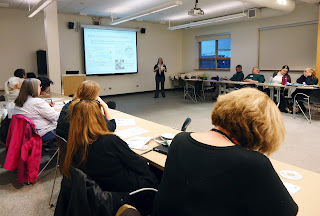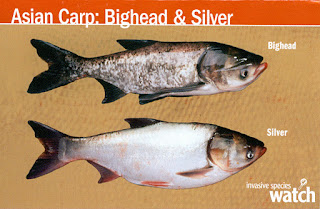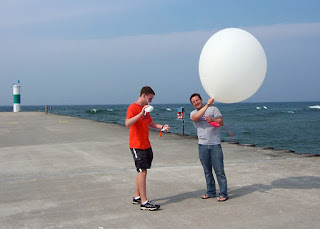February 14th, 2012 by Irene Miles
This year, anglers and boaters who attended the “Let’s Go Fishing Show” in Collinsville, Illinois from January 6–8 got a chance to do more than buy new fishing gear and check out the latest boats. Two IISG specialists joined forces to provide information about ways they can help protect rivers and lakes.
Laura Kammin, pollution prevention program specialist, and Sarah Zack, aquatic invasive species specialist, co-hosted a booth to highlight some of the problems facing our waters—improper disposal of unwanted medicines and aquatic invasive species. They explained to nearly 240 show attendees how to find local medicine collection programs or how to safely dispose of unwanted medicines if programs are not available in their area. In addition, showgoers were able to explore IISG’s display of aquatic invasive species information, including preserved specimens and Asian carp mounts. More than 360 boaters and anglers were informed of the Stop Aquatic Hitchhikers!™ campaign, which explains what steps to take to prevent the transport of invasive species.
Show attendees were very impressed with the IISG booth. Several people shared how glad they were to see this information made available. One visitor even went so far as to say that the IISG booth was the best booth he’d seen, and that it was the most important booth at the show. Laura and Sarah will team up again at the “Rockford Boat, Vacation, and Fishing Expo” from February 17–19.
For more information on how you can safely dispose of medicine contact Laura Kammin. For more information about aquatic invasive species and the Stop Aquatic Hitchhikers!™ campaign contact Sarah Zack or visit www.protectyourwaters.net.
The Illinois-Indiana Sea Grant AIS outreach team is part of the Illinois Natural History Survey Lake Michigan Biological Station in Zion.
February 13th, 2012 by Irene Miles
The Sheboygan River in Wisconsin is a priority Area of Concern (AOC) for cleanup, restoration, and remediation according to the EPA. IISG’s Caitie McCoy has been working directly with communities in all of the Great Lakes areas, and attended a meeting in late January in Sheboygan to discuss the river cleanup project with the people who rely on and care for the river.
Caitie has been actively involved with the Sheboygan AOC since April of last year, when she began a case study on the river in order to understand community concerns and perspectives on the river, the needs of the community, and potential benefits and challenges of a remediation and restoration plan. The case study allowed Caitie and IISG intern Ada Morgan to develop a full understanding of the area, as well as grow beneficial relationships within the community to assist in planning the project.
The January meeting in Sheboygan, hosted by several partners in the project, as well as the project team and the USEPA, provided another networking opportunity and another chance for Caitie to work directly with the project team and the community on ensuring the best plan and path for the project.
Illinois-Indiana Sea Grant has a special collaboration with the USEPA Great Lakes National Program Office, which allows Caitie to be involved in AOCs throughout the Great Lakes area, and to interact with the respective communities to benefit the projects and the people. Through collaborations like this, Caitie has the opportunity to work with other Sea Grant programs, including the Wisconsin Sea Grant. They will be working together to complete a video that will offer boaters, residents, and others important details on how a remediated Sheboygan river can benefit them.
For more information on current AOCs and the organizations that are working together to clean up these sites, contact Caitie McCoy, and visit the USEPA webpage for further details.
February 7th, 2012 by Irene Miles
IISG’s Molly Woloszyn organized a workshop for several Chicago-area teachers recently, and wrote us to share news of the event.
—-

On January 31st, I had the opportunity to help organize and present at a workshop for several Chicago Public School teachers titled “Climate Change: What Is It and What Does It Mean for Illinois?” The workshop attendees all lead after school conservation clubs for 6th-12th graders through the Chicago Conservation Corps (C3), a program of the Chicago Department of Transportation.
C3 project coordinator Kristen Pratt invited me to speak to the teachers about the basics of climate science and climate change. I did this workshop in collaboration with the Illinois State Climatologist, Dr. Jim Angel, who enriched the workshop by sharing his abundant knowledge on the climate of Illinois, as well as projections for the future of Illinois’ climate.
After receiving feedback from the teachers, I was thrilled to hear that they learned a lot about climate science and climate change, a topic that is very important to them and especially relevant nowadays. Many teachers said they found it valuable to learn what is happening with the climate in Illinois and more specifically in Chicago.
The topics I spoke to the teachers about included climate variability, the natural controls of climate and climate change, the influence humans can have on Earth’s climate system, the greenhouse effect, and the main sources for greenhouse gas emissions in the United States and Chicago.
Not only were the teachers enthusiastic to learn about the topic, they were also eager to share the information with their students, which I think is one of the best results from the workshop.
The mission of the C3 Student Clubs Program is to recruit, train, and support a network of teachers and students to improve the quality of life in their schools and neighborhoods through environmental service projects that protect water, clean air, restore land, and save energy.
February 6th, 2012 by Irene Miles
Sea Grant’s bighead and silver carp WATCH card is new and improved. In addition to the fresh design, we’ve changed the card to highlight the term “Asian carp” to match what people are hearing in the media, added pictures of the juvenile fish in comparison with a native shad, and included the national STOP Aquatic Nuisance Species (ANS) phone number.
Click here for more information: https://www.ideals.illinois.edu/handle/2142/99765

February 2nd, 2012 by Irene Miles
The American Veterinary Medical Association (AVMA) has created a new webpage that provides information, tips, and safe practices for veterinarians, pet owners, and the public at large to keep unwanted medicine out of the water supply.
The most common poisons that threaten our beloved pets are our own medicines—ibuprofen, acetaminophen, antidepressants, and ADHD medications. Any medication, even those prescribed for a pet, can pose a risk to dogs or cats who decide to eat what they find.
That is why Sea Grant and the AVMA have teamed up to provide information for multiple audiences including animal owners who, along with the general public, may need to dispose of unused and expired medicine. By offering valuable disposal tips, safe disposal collection locations, and more, the new webpage and the partnership between IISG and the AVMA look to make things safer for pets, people, and the environment.
The partnership kicked off in a big way when Sea Grant and the AVMA joined forces to get the message—”Don’t flush medicine”—to a Times Square audience.
January 26th, 2012 by Irene Miles
University of Illinois atmospheric scientist David Kristovich tested a mobile sounding system that might help predict the fate of storms that move across Lake Michigan. This system measures temperature, humidity, and atmospheric pressure.
“The Great Lakes make it difficult to predict summer weather. One problem weather forecasters face is determining what will happen when massive storms reach one side of the lake. It is hard to figure out if those storms will make it across to the other side and cause severe weather,” Kristovich said. “We don’t have a lot of information. On the lake, we don’t have people taking observations all over the place like we do on land.”
The device they used is called a rawinsonde, which is attached to a weather balloon with a parachute. Because the system is connected to a balloon, researchers were also able to record the wind direction and speed.
Kristovich said having a test run for the device was critical for ironing out issues for future projects.
This study is one of many funded as development of “seed” grants for researchers, either to begin start-up studies that may grow into larger work, or to complete ongoing projects. This project and others are highlighted in our latest issue of our newsletter, The Helm.
January 11th, 2012 by Irene Miles
Purdue University ecologist Patrick Zollner studied how people walking on nature trails can affect the reproduction habits of the Karner blue butterfly, which is a federally endangered species.
Resource managers are under increasing pressure to implement strategies that address the negative effects of outdoor recreational activities on wildlife. The study shows that human recreation can disrupt the breeding patterns of Karner blue butterflies, as well as other species.
Using a simulation model, the project found that significantly fewer eggs are laid by Karner blue butterfly females in sites at the Indiana Dunes National Park that are 10-15 meters from the trail. Plants that are farthest away have the most eggs. Zollner suggests that habitat patches be at least 25 meters from the trail.
“Depending on the circumstances, about 17 percent of the females are only laying half of their potential eggs because of human dis¬turbance,” Zollner said.
Zollner has studied how traffic affects Indiana wildlife and has submitted a proposal to study how the Huron-Manistee National Forest equestrian population impacts Karner blue butterflies.
This study is one of many funded as development of “seed” grants for researchers, either to begin start-up studies that may grow into larger work, or to complete ongoing projects.
This project and others are highlighted in our latest issue of our newsletter, The Helm. You can also read the complete study (PDF).
January 5th, 2012 by Irene Miles
IISG’s Asian Carp Marketing Summit in September of 2010 played a significant role in bringing jobs and invasive species solutions to Illinois, as highlighted in one of The Telegraph’s Top 10 local stories of 2011.
The summit brought together representatives from restaurants, commercial fishing, processing and related businesses, as well as agencies and academic institutions to discuss ways to address the potential threat that Asian carp pose to the Illinois River and the Great Lakes.
January 4th, 2012 by Irene Miles
 Times Square—some call it the crossroads of the world. Annually, over 450 million people pass through this historic and dazzling site.
Times Square—some call it the crossroads of the world. Annually, over 450 million people pass through this historic and dazzling site.Since late December 2011 (which included the world famous New Year’s Eve celebration that attracts many, many thousands) Sea Grant and the American Veterinary Medical Association (AVMA) are informing audiences on the issue of medicine disposal on the CBS JumboTron “Super Screen.” The 15-second spot will run through March 31 about 18 times every day or about every 80 minutes. The screen is located on 42nd Street between 7th and 8th avenues in Times Square Plaza.
The public service announcement is raising awareness on the importance of not flushing unused medicine. Audiences are informed that medicines can contaminate lakes, rivers and drinking water, posing a threat to people, animals, and the environment.
This opportunity came about as a result of the publicity related to the partnership between NOAA’s National Sea Grant College Program and the AVMA, which was officially established in November in a Memorandum of Understanding. Illlinois-Indiana Sea Grant is conducting the MOU on behalf of National Sea Grant on the issue of medications dispensed for animals as well as people.
Visit
unwantedmeds.org to learn some sensible disposal options for unused medicine or contact Laura Kammin for more information on medicine collection programs.











